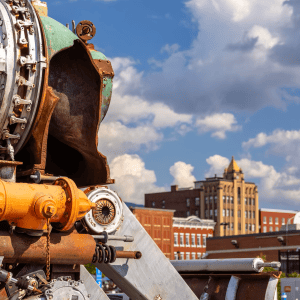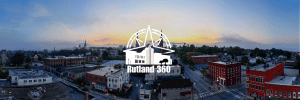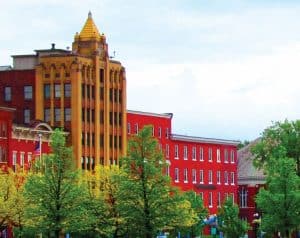Rutland is more than a city with good bones. It’s a place with real potential, the kind that can attract and retain residents for generations to come.
Over the past several months, these articles have been the task force’s effort to inform you—our reader, and presumably a resident of the Rutland region—about Tax Increment Financing (TIF): what it is, what it isn’t, and what it’s meant to achieve. While we’ve occasionally ventured into the weeds of policy detail, this week we’re setting our sights higher—roughly seven stories up, to be exact. Nestled in a valley between lakes to the west and Killington to the east, Rutland is more than a city with good bones. It’s a place with real potential, the kind that can attract and retain residents for generations to come.
“I am from Rutland and have never seen the Downtown operate at its full potential”, said Ed Bove, Rutland City Planning Director. “I would like to see expanded economic and social opportunities for my teenage children now…and something for them to return to after college, trade school, travel or whatever path they choose.”
The TIF District offers a once-in-a-generation chance to bring the vision of a vibrant downtown to life. Lyle Jepson, Executive Director of the Chamber and Economic Development of the Rutland Region, commented: “There is a need for a vibrant downtown community culture that offers experiences in the arts, entertainment, fine dining and boutique retail shops.”
These are not abstract goals. By using the tools provided by the TIF District, Rutland residents have the chance to support core infrastructure improvements, like new sidewalks, beautiful streetscapes, updated waterlines and better stormwater management, without increasing local taxes. Supporting these investments is to make Rutland a place where young people choose to stay, where families grow and where local businesses succeed.
Jepson continued, “The shared vision includes preserving the historical integrity of the City. As immigrants from distant nations, Rutland’s roots are firmly grounded in a vision that includes maintaining and enhancing a downtown that is vibrant with activity, one that serves as a destination location.”
Preserving beloved community traditions, like annual festivals, parades, the Farmer’s Market, and institutions such as the Paramount Theater, Wonderfeet Kids Museum, and The Hub CoWorks, depends on the strength of the infrastructure that supports them. By investing in these foundational needs, we ensure these local gems continue to thrive and pave the way for even more to come.
Rutland was once the economic powerhouse of Vermont, and in many ways it remains at its heart. Built on a legacy of resilience and hard work, and shaped by the people who believe in its promise, we have the chance to honor that legacy by investing in the areas that need our attention the most. Together, we can build a future that reflects Rutland’s past and that ensures the next generation sees their future here, too.
In the coming weeks, we will update you on the results of our first phase filing to the Vermont Economic Progress Council (VEPC). Pending VEPC’s approval, we will have more information on the bond vote anticipated to be October 7, which will be necessary to fund the first round of infrastructure projects. We will also outline how local taxes will not be influenced by the bond.
For more information, visit the Rutland 360 website: https://www.rutlandvtbusiness.com/tax-increment-financing/ or email Ed Bove ([email protected])
About the Rutland City Task Force and Rutland 360. A collaborative initiative, Rutland 360 is led by the Rutland Redevelopment Authority, the City of Rutland, the Chamber & Economic Development of the Rutland Region, and the Downtown Rutland Partnership. Together, these stakeholders (known as the “Task Force”) have developed the Rutland City TIF District Master Plan, a strategic effort to drive economic growth and revitalization in our city.



